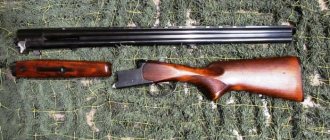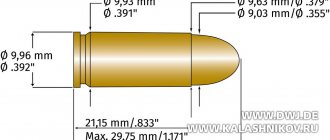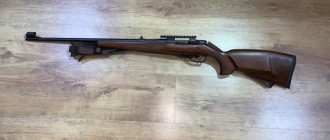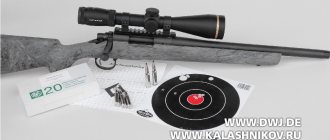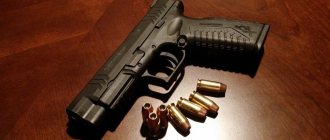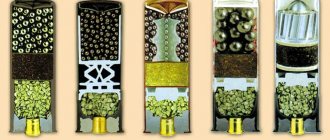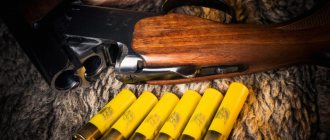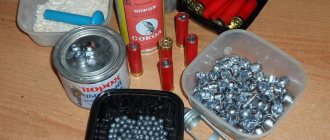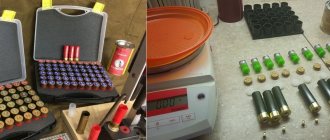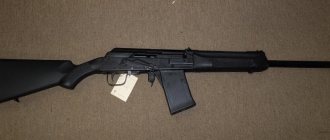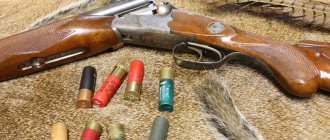- June 9, 2019
- Weapons and ammunition
- Alexey Emelyanov
The 7.62 NATO caliber cartridge (Russian designation - 7.62x51) is developed on the basis of the long-used T65 cartridge (T65E3). The latter was born as a result of reducing the cartridge case of the .30-06 Springfield cartridge. The .30-06 caliber is used to fire the M1 Garand rifle. This was the weapon most often used by American soldiers during World War II. After the end of the military conflict, the army needed a new rifle cartridge with spherical powder.
The appearance of American ammunition in Russia
Cartridge caliber .308 Win. (Russian caliber 7.62x51) had difficulty adapting to the conditions of the Russian market. According to one legend, this ammunition first appeared thanks to the President of the United States, who, after signing the disarmament treaty (SALT-1), presented Leonid Brezhnev with a Winchester-308 carbine and a pack of cartridges for it. The General Secretary of the CPSU Central Committee, who loved to hunt game, appreciated the gift and soon went hunting. Caliber .308 Win. Leonid Ilyich liked it, and he gave the order to produce an American hunting cartridge and weapons for it in the USSR.
The standard of accuracy - Remington 308 caliber
Hunting weapons for 308 caliber have the richest line of model options. The sliding bolt of the main models of single-shot and repeating rifles of this company is structurally based on the Mauser rifle of the early 20th century. 308 caliber allows you to create a wide range of weapons, from sports models to commercial weapons typical for hunting in the northern regions of the American continent. The accuracy of Remington rifles chambered for the .308 cartridge is unsurpassed. For under $3,000 you can find a .308 Remington rifle for almost any civilian purpose, including hunting, sporting and defense. The high accuracy is due to the reliance on American weapons traditions and meets the requirements for NATO military weapons, where the 308 cartridge is one of the main ammunition for both assault rifles and machine guns. A shortened case without a flange for 30 caliber provides excellent opportunities for developers to create weapons of high reliability and accuracy, focusing on the needs of the civilian sector. Cheaper versions of domestic 308 caliber cartridges with ballistic characteristics similar to their Western counterparts increase the undeniable advantages of 308 caliber for hunting in Russia. Low recoil, high accuracy and more reliable performance for the reloading mechanism make the 308 caliber indispensable in all areas of application, including not only hunting, but also defense and security.
Creation of the Soviet 7.62x51 mm cartridge
Development of documentation for weapons of .308 Win caliber. (in mm 7.62x51) engineers from ZAO TsNIITOCHMASH began to work in a hurry. Soon the production of carbines began according to the developed drawings, called “Los-4” and “Bear-3”. Ammunition caliber .308 Win. A machine tool plant located in the city of Barnaul began to produce a semi-shell bullet.
After the collapse of the USSR, Russian enterprises had the opportunity to expose their products to the American and European markets. At the same time, it turned out that carbines and cartridges of .308 Win. domestically produced products do not meet European requirements for such important parameters as strength and safety. Having done a lot of work on bugs, engineers made significant changes to the design of weapons and cartridges.
In the mid-90s of the last century, Los-7 carbines began to be produced, and in Barnaul they launched production of a new ammunition 7.62x51M.308 Win., where the letter “M” in the name means that the cartridge has been modernized. After the changes were made, domestic weapons fully met the requirements of the secondary battery.
In 1995, a new carbine in .308 Win appeared. dubbed "Vepr-51". At the same time, Barnaul began producing new cartridges for this weapon with two types of bullets: SP and FMJ. Moreover, the first version of the hunting ammunition has a total length of 68 mm, and the second - 71.12 mm.
Benefits of 308 Caliber Hunting Weapon Systems
308 caliber hunting rifles can be multi-shot, automatic, semi-automatic, as well as single-shot and combined, with several barrels of different calibers. Self-loading and automatic carbines chambered for a shortened thirty caliber hit more accurately due to less recoil. The 308 caliber rifle for hunting has a number of other advantages. Single-shot carbines have a lighter bolt with a short stroke, which makes it possible to reduce the length and weight of the weapon without compromising shooting accuracy. The 308 caliber cartridge is universal. Under it you can find single-shot shotguns with both a horizontally sliding bolt and a vertically sliding one. 308-caliber bolt-action carbines are particularly compact, lightweight, and silently reload without delay, and they can have a shock spring in the form of a staple rather than a coil, making these systems trouble-free. There are also advantages that the 308 caliber has. Reviews from hunters indicate that if the magazine fails, these cartridges are easier to load into the chamber manually, one at a time, and with longer cartridges, such as caliber 30-06 and others, this technique is not as effective or not at all not possible due to length. And one more advantage. In repeating shotguns chambered for long cartridges, deformation of the soft shell of the bullet occurs much more often when it is automatically moved into the chamber, which affects the accuracy of the shot. Caliber 308 has much fewer complaints in this regard. Reviews from experts positively evaluate the 308 caliber in this regard, rather than the longer versions of the 30 caliber.
Characteristics of the first domestic cartridge 7.62x54
To answer which beast with caliber .308 Win. It's best to hunt, you should know what types of cartridges are produced in Russia.
The first cartridge mass-produced in the USSR was born in 1974. It was made in accordance with GOST 21169-75. It had only one type of bullet weighing 9.7 grams, a semi-jacketed type with an expansive action. The total weight of ammunition with a load is 25 grams. The single design of the bullet deprives the cartridge of versatility. So its American counterpart, which has 16 types of projectiles that differ in weight and type of design.
The weight of American-made 7.62 mm bullets, depending on the type, ranges from 7.1 to 13 grams. In this case, the initial speed of the projectile, depending on the weight of gunpowder, varies from 750 to 1000 meters per second. The maximum pressure of powder gases resulting from a shot is 3600 atmospheres. Such parameters of a hunting cartridge allow you to make the weapon more versatile. Depending on the purpose of the hunt, the shooter can change the type of ammunition.
Ballistics of imported cartridges
Imported cartridges are quite different from the ammunition produced in our country. To verify this, you can familiarize yourself with the characteristics of shells fired abroad:
| Manufacturer and type of ammunition | Bullet weight | Initial bullet speed | Muzzle energy | Deviation rate |
| Lapua Lock-Base | 170 grains | 860 /ms | 4068 J | 19 mm |
| Hornedy Light Magnum SST | 150 grains | 915 m/s | 4075 J | 18 mm |
| Federal Sierra HPBT | 168 grains | 823 m/s | 3631 J | 20.5 mm |
| Remington Swift Scirocco | 180 grain | 823 m/s | 3961 J | 21 mm |
| Norma Nosler | 180 grain | 796 m/s | 3694 J | 29.5 mm |
| Winchester Ballistic | 168 grains | 814 m/s | 3606 J | 21.8 mm |
| Winchester Partition | 150 grains | 884 m/s | 3800 J | 19.8 mm |
The ballistics of European and American .308 Win cartridges is at a completely different level than that of the ammunition produced in Russia. However, it is important to understand that the cost of such shells will be at an appropriate level. So it’s worth choosing what’s more important: respecting the budget or the maximum probability of a good shot.
Improving the quality of domestic ammunition
At the end of the 20th century, JSC Barnaul Machine Tool Plant began producing the .308 Winchester Super cartridge, which has improved ballistic characteristics. When firing this ammunition at a distance of 100 meters, the diameter does not exceed 30 mm, and at a distance of 200 meters - no more than 45 mm. The designers achieved this result as a result of refining the bullet design, as well as reducing tolerances. In addition, the plant has improved the quality of the produced sleeve with a height of 51 mm. The weight of the .308 Winchester Super projectile is 9.72 grams. The tail part of the bullet is made in the form of a cone, and the head part has a hole with a cavity for rapid deployment in the body of the victim. The shell of the projectile is made of bimetal, and there is a lead tip inside. The speed at a distance of 25 meters reaches 820 meters per second with a pressure in the barrel and chamber of the weapon of 304 MPa. This cartridge is used for shooting from the following domestically produced carbines:
- MTs-125.
- MTs-126.
- "Bear-3".
- "Bear-4".
- MC-7-07.
- MC-110-07.
Thirty gauge predecessors
The history of the American thirty-caliber goes back to the “government cartridge” 45-70 Government, the production of which began in 1873.
It was a heavy and low-power ammunition for a single-shot military Springfield rifle with the following characteristics:
1. Caliber – 11.63 mm. 2. Powder charge - 4.54 g. 3. Bullet weight - 26.2 g. 4. Power - 3000 J.
It was a cartridge of the transitional era, when black powder was replaced by smokeless pyroxylin types. Its ballistic characteristics and stopping effect are very close to those of a shot from a 16-gauge shotgun. At the turn of the century, the American army needed a new cartridge, lighter, smokeless powder and smaller caliber for repeating rifles. So in 1892 the 30-40 Krag cartridge for Krag-Jorgensen rifles appeared. It was the earliest member of the American 30-gauge cartridge family, featuring a classic bottle-shaped case. The main difference between this cartridge and subsequent developments is the protruding flange at the rear end of the cartridge case. Its characteristics were as follows:
1. Caliber - 7.8 mm. 2. Length – 78.5 mm. 3. Bullet – 6-13 g. 4. Initial speed – 883-820 m/s. 5. Muzzle energy – 2529 J.
This was a sharp leap towards increasing the range and accuracy of fire. At a distance of 200 m, when shooting along a flat trajectory, the bullet goes down 2 cm. For military purposes, this cartridge was not used for long, but it is still used for hunting large animals up to 250 kg.
Types of Russian .308 Win cartridges
Many hunters are interested in what caliber .308 Win. characteristics and what type of bullet this domestically produced ammunition has. This type of hunting shells is produced by two Russian enterprises: Barnaul Machine Tool. The cartridges are available with various bullets such as FMJ, HP, SP, as well as HPBT. They differ from each other in the presence of the shell, shape and type of core.
The main representatives of the American thirty gauge
All cartridges in this family have the same bottle case shape as the 30-40 Krag, but they do not have a raised flange.
The main representatives of the thirty caliber were developed as a small-caliber class of ammunition for handguns. These cartridges differ in the length of the case, which affects the amount of gunpowder, as well as the shape, weight and design of the bullet. The case without a protruding flange is a German development and is intended for rifles with a box magazine such as the Mauser M 98. The first representative of the classic series of American thirty-caliber cartridges was ammunition for Springfield rifles, which are copies of the above-mentioned German rifle with a box magazine and a free-sliding rotary bolt. At the beginning of the twentieth century, two such ammunition appeared. These are calibers 30-03 and 30-06 Springfield. Both cartridges differ from each other in the size of the cartridge case and the shape of the bullet. The 30-06 caliber has a 1.77mm shorter case, but the most significant difference is the bullet design. Caliber 30-03 has a heavy bullet weighing 14.3 g with a round head. This bullet did not have high enough shooting characteristics, but it has excellent stopping properties. These characteristics became the reason for its short military career and its rapid transition to the category of hunting ammunition. The last two digits in the caliber designation indicate the year these cartridges were adopted by the US Army. Caliber 30-03 - 1903 Caliber 30-06 - 1906 The adoption of a new thirty-caliber cartridge in just three years was due to a bullet. The Germans began making pointed bullets for their repeating rifles, which were lighter and had greater accuracy. The United States immediately responded to the German innovation and adopted its own version of the cartridge with a pointed full-jacket bullet weighing 9.7 g. This is how caliber 30-06 appeared, which is still used as military ammunition; it is considered the most common hunting cartridge in the world.
Characteristics and types of Novosibirsk cartridges
The plant in Novosibirsk produces 7.62x51 mm hunting caliber cartridges with two types of bullets: HP and FMJ. Their characteristics are detailed in the table below.
| Bullet name | Bullet weight in grams | The speed of the projectile, measured at a distance of 25 meters from the weapon | The highest pressure of powder gases |
| HP | 9,7 | 830 | 304 |
| FMJ | 9,7 | 750 | 304 |
Ammunition for civilian weapons of 7.62x51 mm caliber, manufactured at the plant in Novosibirsk, is the most stable in its characteristics. They are of higher quality compared to similar products produced in Barnaul.
Characteristics and types of Barnaul cartridges
Barnaul cartridges are less stable in their characteristics, as demonstrated in the table below:
| Bullet name | Bullet weight in grams | Transverse dispersion of bullets when fired at a distance of 100 meters from the muzzle of the barrel, measured in millimeters | The speed of the projectile, measured at a distance of 25 meters from the weapon | The highest pressure of powder gases, measured in MPa using the piezoelectric method | The total length of the ammunition, measured in millimeters | Total mass of ammunition, measured in grams |
| SP | 9,1 | 80 | 855 | 333,4 | 68 | 21,6 |
| FMJ | 9,4 | 100 | 840 | 333,4 | 71,12 | 21,9 |
| HPBT | 9,72 | 30 | 840 | 333,4 | 71,12 | 22,6 |
Using the table values, it is worth remembering that the speed of the projectile thrown is calculated based on average data after three series of ten shots. In this case, the speed of the bullet at different distances will differ significantly, especially beyond 500 meters. The speed of a bullet can be affected by gusts of wind, air temperature, batch of ammunition, type of weapon used to fire and other factors. If the barrel length is short, then the initial velocity will be much lower than indicated in the table.
Ballistic tables 7.62 x 51 mm | 308 Win | 7.62 x 54 mm
The main tables provide data characterizing the trajectories of bullets under normal shooting conditions. The following are considered to be normal (tabular) shooting conditions:
- the target is on the weapon's horizon
- there is no lateral tilt of the weapon
- air pressure 750 mm Hg. pillar
- air temperature +15 degrees C
- relative humidity 50%
- charge temperature +15 degrees C
- there is no wind
- Departure angle, initial velocity and bullet weight are tabulated
SHOOTING TABLE VSK-94
Cartridge SP-5 Bullet weight 16.1 g Initial bullet speed 290 m/s
| D, m | Excess of trajectory above the aiming line, m at ranges | |||||||||
| 50 m | 100 m | 150 m | 200 m | 250 m | 300 m | 350 m | 400 m | 450 m | 500 m | |
| 100 | 0,13 | 0 | — 0,45 | — 1,23 | — 2,35 | |||||
| 200 | 0,44 | 0,61 | 0,47 | 0 | — 0,81 | — 1,97 | ||||
| 300 | 0,77 | 1,27 | 1,46 | 1.32 | 0,83 | 0 | — 1,20 | — 2,77 | ||
| 400 | 1,17 | 1,96 | 2,50 | 2,70 | 2,56 | 2,08 | 1,23 | 0 | — 1,62 | — 3,63 |
TABLES OF FIRING FROM 7.62 MM SVD
Bullet with a steel core Bullet weight 9.6 g Initial bullet speed 830 m/s Departure angle zero minutes Muzzle energy 337 kgm
Main table for the SVD sniper rifle
| Range | Aiming angle | Throwing angle | Angle of incidence | |||
| m | hail min | thousand | hail min | thousand | hail min | thousand |
| 100 | 0 06 (0 05) | 1,7 (1,4) | 0 03 | 0,8 | 0 03 | 0,8 |
| 200 | 0 08 (0 07) | 2,2 (1,9) | 0 06 | 1,7 | 0 06 | 1,7 |
| 300 | 0 10 | 2,8 | 0 09 | 2,5 | 0 10 | 2,8 |
| 400 | 0 11 | 3,9 | 0 13 | 3,6 | 0 16 | 4,4 |
| 500 | 0 18 | 5,0 | 0 18 | 5,0 | 0 24 | 6,7 |
| 600 | 0 23 | 6,4 | 0 23 | 6,4 | 0 35 | 9,7 |
| 700 | 0 29 | 8,1 | 0 29 | 8,1 | 0 48 | 13 |
| 800 | 0 36 | 10 | 0 36 | 10 | 1 05 | 18 |
| 900 | 0 45 | 12 | 0 45 | 12 | 1 26 | 24 |
| 1000 | 0 55 | 15 | 0 55 | 15 | 1 50 | 31 |
Aiming angles for open sights are shown in parentheses. In other cases, the aiming angle values for optical and open sights are the same.
| Range | Path height | Horizontal distance to the top of the trajectory | Total bullet flight time | Final bullet speed | Bullet energy at impact point |
| m | m | m | With | m/s | kgm |
| 100 | 0,02 | 51 | 0,13 | 755 | 279 |
| 200 | 0,09 | 103 | 0,27 | 685 | 229 |
| 300 | 0,22 | 157 | 0,42 | 618 | 187 |
| 400 | 0,43 | 213 | 0,59 | 554 | 150 |
| 500 | 0,75 | 271 | 0,78 | 495 | 120 |
| 600 | 1,2 | 331 | 0,99 | 441 | 95 |
| 700 | 1,9 | 394 | 1,23 | 392 | 75 |
| 800 | 2,8 | 459 | 1,50 | 350 | 60 |
| 900 | 4,0 | 525 | 1,80 | 320 | 50 |
| 1000 | 5,7 | 591 | 2,12 | 302 | 45 |
Excess of trajectories above the aiming line of an optical sight for SVD
| Aim | Range, m | |||||||||||
| 50 | 100 | 150 | 200 | 250 | 300 | 350 | 400 | 450 | 500 | 550 | 600 | |
| Centimeters | ||||||||||||
| 1 | — 1 (0) | 0 | — 3 (- 4) | — 11 (- 14) | ||||||||
| 2 | 1 (3) | 5 (6) | 4 (5) | 0 | — 11 | — 28 | ||||||
| 3 | 6 (8) | 14 (16) | 18 (19) | 17 (18) | 11 | 0 | — 18 | — 44 | ||||
| 4 | 11 (14) | 25 (27) | 35 (37) | 39 (40) | 39 | 33 | 20 | 0 | — 28 | — 65 | ||
| 5 | 18 (21) | 38 (40) | 53 (55) | 64 (66) | 70 | 70 | 64 | 50 | 28 | 0 | — 43 | — 94 |
| Aim | Range, m | |||||||||
| 100 | 200 | 300 | 400 | 500 | 600 | 700 | 800 | 900 | 1000 | |
| Meters | ||||||||||
| 6 | 0,53 (0,56) | 0,95 (0,97) | 1,2 | 1,1 | 0,7 | 0 | — 1,3 | — 3,4 | ||
| 7 | 0,71 (0,74) | 1,3 | 1,7 | 1,9 | 1,6 | 1,0 | 0 | — 1,7 | — 3,4 | |
| 8 | 0,94 (0,97) | 1,8 | 2,4 | 2,7 | 2,8 | 2,4 | 1,5 | 0 | — 2,2 | — 5,5 |
| 9 | 1,2 | 2,2 | 3,1 | 3,7 | 4,0 | 3,9 | 2,3 | 2,0 | 0 | — 2,9 |
| 10 | 1,5 | 2,8 | 4,0 | 4,9 | 5,4 | 5,7 | 5,3 | 4,3 | 2,6 | 0 |
The values of excess for an open sight are given in parentheses. In other cases, the excess values for optical and open sights are the same.
Correction data for meteorological conditions and derivation for SVD
| Firing range, m | Horizontal (lateral) corrections | ||||
| Side wind 4-6 m/s at right angles | Derivation | ||||
| in cm | in thousandths | in human figures | in cm | in thousandths | |
| 100 | 3 | 0,15 | |||
| 200 | 10 | 0,35 | 1 | ||
| 300 | 26 | 0,6 | 0,5 | 2 | 0,1 |
| 400 | 48 | 0,95 | 1 | 4 | 0,1 |
| 500 | 72 | 1,3 | 1,5 | 7 | 0,1 |
| 600 | 110 | 1,7 | 2 | 12 | 0,2 |
| 700 | 160 | 2,1 | 3 | 19 | 0,2 |
| 800 | 220 | 2,6 | 4,5 | 29 | 0,3 |
| 900 | 290 | 3.1 | 6 | 43 | 0,5 |
| 1000 | 370 | 3.7 | 7,5 | 62 | 0,6 |
| Firing range, m | Vertical adjustments in centimeters | ||
| Longitudinal wind 10 m/s | Temperature deviation by 10 degrees | Deviation of atmospheric pressure by 10 mm | |
| 100 | |||
| 200 | 1 | ||
| 300 | 2 | ||
| 400 | 5 | 1 | |
| 500 | 10 | 2 | |
| 600 | 1 | 17 | 3 |
| 700 | 3 | 28 | 5 |
| 800 | 8 | 43 | 8 |
| 900 | 15 | 64 | 14 |
| 1000 | 26 | 92 | 21 |
Moving the target in figures during the flight of the SVD bullet
| Range, m | Moving the target in figures during the flight of the bullet at the speed of the target's movement | |||||||||||||
| Shooter | Motorbike | Car | ||||||||||||
| step 1.5 m/s | running 3 m/s | 10 km/h | 20 km/h | 30 km/h | 40 km/h | 50 km/h | 60 km/h | 10 km/h | 20 km/h | 30 km/h | 40 km/h | 50 km/h | 60 km/h | |
| 100 | 0,5 | 0,5 | 0 | 0,5 | 0,5 | 0,5 | 1 | 1 | 0 | 0 | 0 | 0 | 0,5 | 0,5 |
| 200 | 1 | 1,5 | 0,5 | 0,5 | 1 | 1,5 | 1,5 | 2 | 0 | 0 | 0,5 | 0,5 | 0,5 | 0,5 |
| 300 | 1 | 2,5 | 0,5 | 1 | 1,5 | 2 | 2,5 | 3 | 0 | 0,5 | 0,5 | 1 | 1 | 1 |
| 400 | 2 | 3,5 | 0,5 | 1,5 | 2 | 3 | 3,5 | 4,5 | 0,5 | 0,5 | 1 | 1 | 1,5 | 1,5 |
| 500 | 2,5 | 4,5 | 1 | 2 | 3 | 3,5 | 4,5 | 5,5 | 0,5 | 0,5 | 1 | 1,5 | 2 | 2 |
| 600 | 3 | 6 | 1 | 2,5 | 3,5 | 5 | 6 | 7 | 0,5 | 1 | 1,5 | 2 | 2,5 | 3 |
| 700 | 3,5 | 7,5 | 1,5 | 3 | 4,5 | 6 | 7,5 | 9 | 0,5 | 1 | 1,5 | 2,5 | 3 | 3,5 |
| 800 | 4,5 | 9 | 2 | 3,5 | 5,5 | 7 | 9 | 11 | 0,5 | 1,5 | 2 | 3 | 3,5 | 4 |
| 900 | 5,5 | 11 | 2 | 4,5 | 6,5 | 8,5 | 11 | 13 | 1 | 1,5 | 2,5 | 3,5 | 4 | 5 |
| 1000 | 6,5 | 12 | 2,5 | 5 | 7,5 | 10 | 12,5 | 15,5 | 1 | 2 | 3 | 4 | 5 | 6 |
Dispersion characteristics for SVD
Shooting with an optical sight while lying down
| Range, m | Best snipers | Medium snipers | ||||||
| Average dispersion deviations for | ||||||||
| Sniper cartridge | Cartridge with LPS bullet | Sniper cartridge | Cartridge with LPS bullet | |||||
| By height | Lateral | By height | Lateral | By height | Lateral | By height | Lateral | |
| Centimeters | ||||||||
| 100 | 1,3 | 1,4 | 1,9 | 2,1 | 3 | 2,1 | 4,3 | 3,1 |
| 200 | 2,6 | 2,8 | 3,8 | 4,2 | 6 | 4,2 | 8,6 | 6,2 |
| 300 | 3,9 | 4,2 | 5,7 | 6,3 | 9 | 6,3 | 12,9 | 9,3 |
| 400 | 5,2 | 5,6 | 7,6 | 8,4 | 12 | 8,4 | 17,2 | 12,4 |
| 500 | 7,1 | 7 | 9,9 | 10,6 | 15,3 | 10,6 | 21,7 | 15,6 |
| 600 | 9,4 | 8,8 | 12,5 | 13 | 18,9 | 13,0 | 26,2 | 19,2 |
| 700 | 12,1 | 10,8 | 15,6 | 15,5 | 23 | 15,5 | 31 | 23 |
| 800 | 15 | 13 | 19 | 18 | 27 | 18 | 36 | 27 |
| 900 | 19 | 16 | 23 | 22 | 31 | 22 | 42 | 31 |
| 1000 | 25 | 21 | 29 | 26 | 37 | 26 | 48 | 35 |
Ballistic table 7 , 62x51
| Name | Coef. forms (according to Siacci) | Bal.coefficient (according to Siacci) | Distance, m | |||||||||||||||||||||||||
| 0 | 25 | 50 | 75 | 100 | 125 | 150 | 175 | 200 | 225 | 250 | 275 | 300 | ||||||||||||||||
| V0 | E0 | V25 | E25 | V50 | E50 | V75 | E75 | V100 | E100 | V125 | E125 | V150 | E150 | V175 | E175 | V200 | E200 | V225 | E225 | V250 | E250 | V275 | E275 | V300 | E300 | |||
| Hunting cartridge 308Win (7.62x51) with an expansive bullet SP Bullet weight 9.2-9.4 g Bimetallic jacket Bimetallic sleeve | 0.586 | 3.660 | 830 | 3201 | 820 | 3125 | 810 | 3049 | 799 | 2971 | 789 | 2892 | 779 | 2824 | 769 | 2745 | 759 | 2677 | 749 | 2608 | 739 | 2539 | 730 | 2480 | 720 | 2412 | 710 | 2343 |
| Hunting cartridge 308Win (7.62x51) with an expansive bullet SP Bullet weight 9.2-9.4 g Tombak shell Brass sleeve | 0.586 | 3.660 | 830 | 3201 | 820 | 3125 | 810 | 3049 | 799 | 2971 | 789 | 2892 | 779 | 2824 | 769 | 2745 | 759 | 2677 | 749 | 2608 | 739 | 2539 | 730 | 2480 | 720 | 2412 | 710 | 2343 |
| Hunting cartridge 308Win (7.62x51) with an expansive bullet SP Bullet weight 9.2-9.4 g Tombak shell Bimetallic sleeve | 0.586 | 3.660 | 830 | 3201 | 820 | 3125 | 810 | 3049 | 799 | 2971 | 789 | 2892 | 779 | 2824 | 769 | 2745 | 759 | 2677 | 749 | 2608 | 739 | 2539 | 730 | 2480 | 720 | 2412 | 710 | 2343 |
| Hunting cartridge 308Win (7.62x51) with FMJ jacketed bullet Bullet weight 9.5-9.7 g Bimetallic jacket Bimetallic sleeve | 0.530 | 3.210 | 829 | 3294 | 820 | 3226 | 811 | 3157 | 802 | 3088 | 793 | 3017 | 784 | 2949 | 775 | 2881 | 766 | 2814 | 758 | 2756 | 749 | 2696 | 740 | 2627 | 732 | 2569 | 723 | 2510 |
| Hunting cartridge 308Win (7.62x51) with FMJ jacketed bullet Bullet weight 9.5-9.7 g Tombak jacket Brass sleeve | 0.530 | 3.210 | 829 | 3294 | 820 | 3226 | 811 | 3157 | 802 | 3088 | 793 | 3017 | 784 | 2949 | 775 | 2881 | 766 | 2814 | 758 | 2756 | 749 | 2696 | 740 | 2627 | 732 | 2569 | 723 | 2510 |
| Hunting cartridge 308Win (7.62x51) with FMJ jacketed bullet Bullet weight 9.5-9.7 g Tombak jacket Bimetallic sleeve | 0.530 | 3.210 | 829 | 3294 | 820 | 3226 | 811 | 3157 | 802 | 3088 | 793 | 3017 | 784 | 2949 | 775 | 2881 | 766 | 2814 | 758 | 2756 | 749 | 2696 | 740 | 2627 | 732 | 2569 | 723 | 2510 |
| Hunting cartridge 308Win (7.62x51) with increased accuracy Bullet weight 11.95-12.05 g Tombak shell Brass sleeve | 0.561 | 2.710 | 750 | 3373 | 743 | 3310 | 736 | 3245 | 729 | 3230 | 721 | 3118 | 714 | 3059 | 707 | 2997 | 700 | 2938 | 693 | 2880 | 686 | 2822 | 679 | 2765 | 672 | 2708 | 666 | 2660 |
| Hunting cartridge 308Win (7.62x51) high accuracy Bullet weight 11.95-12.05 g Tombak shell Brass sleeve | 0.561 | 2.710 | 750 | 3373 | 743 | 3310 | 736 | 3245 | 729 | 3230 | 721 | 3118 | 714 | 3059 | 707 | 2997 | 700 | 2938 | 693 | 2880 | 686 | 2822 | 679 | 2765 | 672 | 2708 | 666 | 2660 |
| Hunting cartridge 308Win (7.62x51) “Extra” Bullet weight 11.95-12.05 g Tombak shell Brass sleeve | 0.561 | 2.710 | 750 | 3373 | 743 | 3310 | 736 | 3245 | 729 | 3230 | 721 | 3118 | 714 | 3059 | 707 | 2997 | 700 | 2938 | 693 | 2880 | 686 | 2822 | 679 | 2765 | 672 | 2708 | 666 | 2660 |
| Hunting cartridge 308Win (7.62x51) with a two-element core Bullet weight 9.7-9.9 g Bimetallic shell Bimetallic sleeve | 0.509 | 3.016 | 809 | 3206 | 800 | 3137 | 792 | 3069 | 783 | 3000 | 775 | 2941 | 767 | 2882 | 759 | 2824 | 750 | 2755 | 742 | 2696 | 734 | 2637 | 726 | 2578 | 718 | 2529 | 710 | 2471 |
| Hunting cartridge 308Win (7.62x51) with a two-element core Bullet weight 9.7-9.9 g Tombak shell Bimetallic sleeve | 0.509 | 3.016 | 809 | 3206 | 800 | 3137 | 792 | 3069 | 783 | 3000 | 775 | 2941 | 767 | 2882 | 759 | 2824 | 750 | 2755 | 742 | 2696 | 734 | 2637 | 726 | 2578 | 718 | 2529 | 710 | 2471 |
Note:
V in m/s - Speed
E in j - Energy
Running in a rifled barrel
Running in a rifled barrel of a .308 Win weapon. should definitely be carried out on a new sample that has never been fired from. The first thing you need to do at the shooting range before loading is to remove the factory grease from the surface and inside. After the barrel is cleaned and degreased, you need to fill the magazine with cartridges and load the carbine.
After three shots, you need to start cleaning the weapon again. To do this, you should use special carbon removers, for example, Sweet's 7.62 or Barnes CR-10. They are especially good at removing shavings and copper left behind after gunpowder burns and the bullet rubs against the barrel. You need to clean until the pitches coming out of the barrel are clean. Next, you should make several more series of three shots, followed by thorough cleaning. Carrying out such an operation will help to successfully test the new weapon and prolong its performance as much as possible.
After the first shooting, you need to thoroughly clean the carbine, using the Outers system for this procedure: Foul Out II or the more modern Foul Out III. Its operating principle is to reverse galvanize the inside of the weapon barrel.
After this, you can begin zeroing the carbine at the shooting range, adjusting sights, extending or shortening the stock, and testing ammunition with different types of bullets.
Optimal twist for 308 caliber
There are several options for .308 twist barrels, ranging from 10 to 14 inches in barrel length. Twist is the full rotation of the bullet around its axis, which it makes when moving in the barrel. Accordingly, a 10-inch twist is the full rotation of the bullet in the barrel, which the bullet makes after passing a ten-inch run along the barrel. The heavier and longer the bullet, the shorter the twist should be. To determine the optimal twist for a .308, you need to know the type of bullet that will be primarily used in hunting. The standard bullet weight of 168 grains can be considered optimal for caliber 308. Reviews indicate that for such a bullet the minimum possible twist will be 14 inches. Lighter bullets with such a twist will be overstabilized, but their ballistics will remain within acceptable deviations. Heavier .308 bullets require a shorter twist. Many hunters say that the .308 requires a 12 twist. For example, the Chezet 550 caliber 308 carbine in various modifications is often cited as an example. Czech rifles are distinguished by a universal bolt for various lengths of 308-caliber cartridges, which itself is quite massive. To reduce the weight of weapons, Czech gunsmiths use a special technology for producing thin-walled barrels, which greatly affects ballistics due to instant overheating of the barrel. For commercial hunting, you need a thick barrel, a simple sight when you can quickly catch a target with a fly, a trouble-free mechanism and a bolt chambered for the cheapest 30 caliber cartridge, which is the 308 caliber. The twist must be designed for the maximum weight and length of the bullet. With all the pros and cons, 308 caliber hunting carbines should be chosen with a 12-inch twist, which will ensure a reliable shot for domestic ammunition equipped with domestic bullets. The 308 caliber has a wider choice of bullet weights at an affordable price, so the 12 twist offers more potential to the weapon.
Reviews of caliber .308 Win
Based on reviews of the .308 Win caliber, we can conclude that many hunters are faced with the problem of selecting ammunition for Vepr-308 weapons. The fact is that special modernized 7.62x51M cartridges were produced for such a carbine. They were shorter in length compared to the classic version of the cartridge produced during the USSR. Due to the discrepancy in the length of the ammunition chamber, the shooter experienced difficulties during loading. The situation is complicated by the fact that the domestically produced 7.62x51M cartridge and foreign ammunition are still difficult to find in Russian gun stores.
In 1997, the Vepr-308 underwent modernization, as a result of which the carbine magazine became universal. Now the weapon can be loaded with any .308 Winchester caliber cartridges. At the same time, the stores had three versions for 5, 7 and 10 rounds.
Another drawback noted by hunters who use the 7.62x51 mm caliber with HP and SP bullets is the fact that the damaging element does not always open in the body of the game, especially when it comes to small animals (various rodents, foxes or wolves ).
Of the positive qualities of the .308 Win cartridge. Many hunters note that this type of ammunition of American origin is very convenient. The bullet hits both small-sized game (hare, fox and others) and medium-sized game (elk and wild boar). This cartridge is not suitable for large animals; the animal may not die instantly, and severe wounding will only anger it. It is very likely that the prey may attack the unlucky hunters.
Shooters note that it is quite difficult to find large animals in the forests of Russia, so this caliber can safely be called universal. It hits the target perfectly and accurately, without much damage to the valuable skin and meat of game.
Differences between .308 Win and 7.62×51 NATO cartridges
Many novice hunters wonder what the difference is between the .308 Winchester and 7.62×51 NATO calibers. It would seem that the cartridges have the same dimensions, which means their characteristics should be the same. However, as you already know, ballistics depends not only on the shape or size of the projectile, but also on its mass - and this is what distinguishes these two ammunition. The military cartridge has a bullet weight of 183.5 grains, while the civilian .308 Win rarely exceeds 170 grains.
Here are a few more features worth noting when comparing these two shells:
- Pressure. Considering that there is more gunpowder in a military cartridge, the shot power will also be higher. Moreover, the difference is almost 20%: for a “NATO” projectile the shot power is in the region of 5000 J, while for a civilian it rarely exceeds 4000 J. Thus, the penetrating power of army ammunition will be higher.
- Sleeve thickness. Another quality of cartridges that cannot be ignored. The civilian version has thinner walls, and the “neck” of the cartridge case is located slightly lower. This means that a military cartridge will simply physically hold more gunpowder, but the projectile will weigh much more.
- Initial bullet speed. Due to the fact that the civilian .308 Win cartridge does not contain as much gunpowder as the 7.62x51 NATO, the two ammunition will also differ in the velocity of the bullet. For the military version it often exceeds 1000 m/s, while for hunting ammunition it averages 800 m/s.
There are also differences in the chambering of rifles. The military-grade cartridge case is slightly thicker than the commercial cartridge, so the 7.62x51 NATO is unlikely to be used in a hunting weapon. However, even if you force a shell into the chamber, you risk encountering problems during reloading or even ruining the rifle. Of course, theoretically, you can encounter .308 Win cartridges of non-standard shape, but the powder load of such projectiles is within the normal range (for a hunting carbine). So it is strongly not recommended to risk the health and integrity of the rifle by using military ammunition on civilian weapons.
